Effects of Embedded Helium on the Microstructure and Mechanical Properties of Erbium Films
Abstract
1. Introduction
2. Experimental Details
2.1. Sample Preparation
2.2. Sample Characterizations
3. Results and Discussions
3.1. Helium Depth Distribution in Er Films
3.2. Microstructures of He-Embedded Er Films and the Morphology of He Bubbles in the Films
3.3. Mechanical Propertiesof He-Embedded Er Films
4. Conclusions
Author Contributions
Funding
Conflicts of Interest
References
- Shen, H.H.; Zu, H.Y.; Peng, S.M.; Yang, L.; Zhou, X.S.; Sun, K.; Xiang, X.; Zu, X.T. On the study of the oriented cracks formed in ErD2 thin film. Mater. Lett. 2013, 106, 259–262. [Google Scholar] [CrossRef]
- Snow, C.S.; Browning, J.F.; Bond, G.M.; Rodriguez, M.A.; Knapp, J.A. 3He bubble evolution in ErT2: A survey of experimental results. J. Nucl. Mater. 2014, 453, 296–306. [Google Scholar] [CrossRef]
- Martínez, E.; Schwen, D.; Caro, A. Helium segregation to screw and edge dislocations in α-iron and their yield strength. Acta Mater. 2015, 84, 208–214. [Google Scholar] [CrossRef]
- Martínez, E.; Hirth, J.P.; Nastasi, M.; Caro, A. Structure of a 2o (010) Cu twist boundary interface and the segregation of vacancies and He atoms. Phys. Rev. B 2012, 85, 060101. [Google Scholar] [CrossRef]
- Terentyev, D.; He, X. Effect of Cr precipitates and He bubbles on the strength of <1 1 0> tilt grain boundaries in BCC Fe: An atomistic study. Comput. Mater. Sci. 2011, 50, 925–933. [Google Scholar]
- Knapp, J.A.; Browning, J.F.; Bond, G.M. Aging of ErT2 thin films: ERD analysis and mechanical property changes. Nucl. Instrum. Meth. B 2010, 268, 2141–2143. [Google Scholar] [CrossRef]
- Brugarolas, T.; Gianola, D.S.; Zhang, L.; Campbell, G.M.; Bassani, J.L.; Feng, G.; Lee, D. Tailoring and Understanding the Mechanical Properties of Nanoparticle-Shelled Bubbles. ACS Appl. Mater. Interfaces 2014, 6, 11558–11572. [Google Scholar] [CrossRef]
- Knapp, J.A.; Browning, J.F.; Bond, G.M. Evolution of mechanical properties in ErT2 thin films. J. Appl. Phys. 2009, 105, 053501. [Google Scholar] [CrossRef]
- Hetherly, J.; Martinez, E.; Di, Z.F.; Nastasi, M.; Caro, A. Helium bubble precipitation at dislocation networks. Scr. Mater. 2012, 66, 17–20. [Google Scholar] [CrossRef]
- Trinkaus, H. Energetics and formation kinetics of helium bubbles in metals. Radiat. Eff. 1983, 78, 189–211. [Google Scholar] [CrossRef]
- Shen, H.H.; Peng, S.M.; Long, X.G.; Xiang, X.; Zhou, X.S.; Yang, L.; Zu, X.T. Microstructure changes of erbium and erbium deuteride films induced by helium implantation. Mater. Lett. 2012, 80, 17–19. [Google Scholar] [CrossRef]
- Bufford, D.; Snow, C.; Hattar, K. Bubble Formation in Er and ErD2 During In Situ He+ Ion Implantation. Microsc. Microanal. 2014, 20, 1828–1829. [Google Scholar] [CrossRef]
- Redstone, R.; Rowland, M.C. High-temperature Hydrogen Isotope Targets. Nature 1964, 201, 1115–1116. [Google Scholar] [CrossRef]
- Graves, E.R.; Rodrigues, A.A.; Goldblatt, M.; Meyer, D.I. Preparation and Use of Tritium and Deuterium Targets. Rev. Sci. Instrum. 1949, 20, 579–582. [Google Scholar] [CrossRef]
- Blackburn, R. Inert Gases in Metals. Metall. Rev. 1966, 11, 159–176. [Google Scholar]
- Höchbauer, T.; Misra, A.; Hattar, K.; Hoagland, R.G. Influence of interfaces on the storage of ion-implanted He in multilayered metallic composites. J. Appl. Phys. 2005, 98, 123516. [Google Scholar] [CrossRef]
- Zhu, H.; Wei, T.; Blackford, M.; Short, K.; Carr, D.; Harrison, R.; Edwards, L.; Seo, D.; Maruyama, K. Irradiation behaviour of α2 and γ phases in He ion implanted titanium aluminide alloy. Intermetallics 2014, 50, 28–33. [Google Scholar] [CrossRef]
- Shi, L.; Liu, C.; Xu, S.; Zhou, Z.Y. Helium-charged titanium films deposited by direct current magnetron sputtering. Thin Solid Films 2005, 479, 52–58. [Google Scholar] [CrossRef]
- Wei, Y.C.; Shi, L.Q.; Zhang, L.; He, Z.J.; Zhang, B.; Wang, L.B. Preparation and thermal desorption properties of dc sputtered zirconium-hydrogen-helium thin films. J. Vac. Sci. Technol. A 2008, 26, 1511–1518. [Google Scholar] [CrossRef]
- Hellgren, N.; Berlind, T.; Gueorguiev, G.K.; Johansson, M.P.; Stafström, S.; Hultman, L. Fullerene-like BCN thin films: A computational and experimental study. Mater. Sci. Eng. B 2004, 113, 242–247. [Google Scholar] [CrossRef]
- Furlan, A.; Gueorguiev, G.K.; Högberg, H.; Stafström, S.; Hultman, L. Fullerene-like CPx: A first-principles study of the relative stability of precursors and defect energetics during synthetic growth. Thin Solid Films 2006, 515, 1028–1032. [Google Scholar] [CrossRef]
- Gao, J.; Bao, L.; Huang, H.; Li, Y.; Lei, Q.; Deng, Q.; Liu, Z.; Yang, G.; Shi, L. ERDA, RBS, TEM and SEM characterization of microstructural evolution in helium-implanted Hastelloy N alloy. Nucl. Instrum. Meth. B 2017, 399, 62–68. [Google Scholar] [CrossRef]
- Schiettekatte, F.; Ross, G.G. ERD spectrum to depth profile conversion program for Windows. AIP Conf. Proc. 1997, 392, 711–714. [Google Scholar]
- Koyanagi, T.; Takao, K.; Fukuma, Y. Effects of He on Cu film formation by rf sputtering. Vacuum 1998, 51, 575–582. [Google Scholar] [CrossRef]
- Hall, E.O. The Deformation and Ageing of Mild Steel: II Characteristics of the L ders Deformation. Proc. Phys. Soc. Sec. B 1951, 64, 742–747. [Google Scholar] [CrossRef]
- Petch, N. The Cleavage Strength Of Polycrystals. J. Iron Steel Inst. Lond. 1953, 173, 25–28. [Google Scholar]
- Christensen, R.M. Two Theoretical Elasticity Micromechanics Models. J. Elast. 1998, 50, 15–25. [Google Scholar] [CrossRef]
- Kumar, K.S.; Van Swygenhoven, H.; Suresh, S. Mechanical behavior of nanocrystalline metals and alloys. Acta Mater. 2003, 51, 5743–5774. [Google Scholar] [CrossRef]
- Vliet, K.J.V.; Tsikata, S.; Suresh, S. Model experiments for direct visualization of grain boundary deformation in nanocrystalline metals. Appl. Phys. Lett. 2003, 83, 1441–1443. [Google Scholar] [CrossRef]
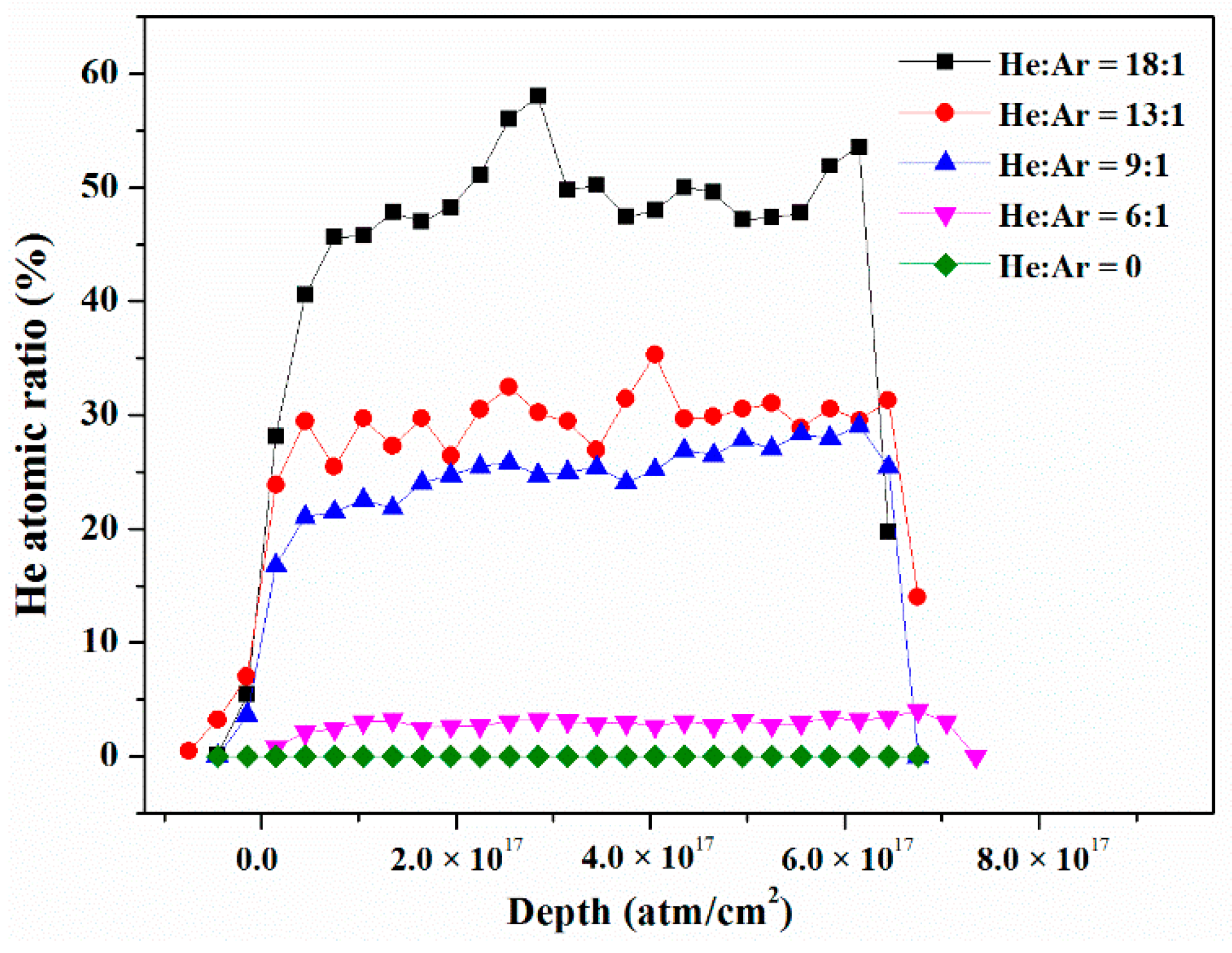
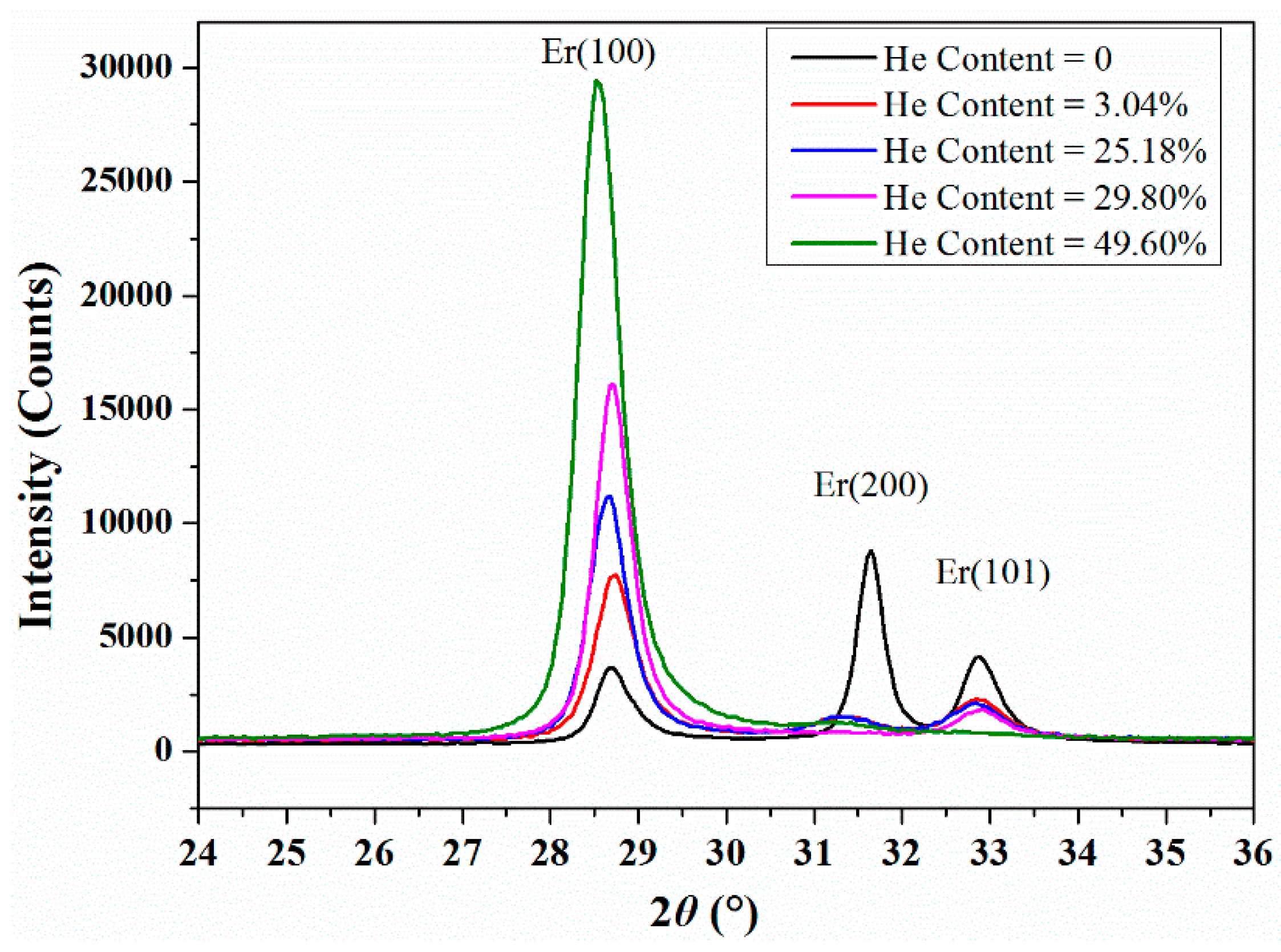
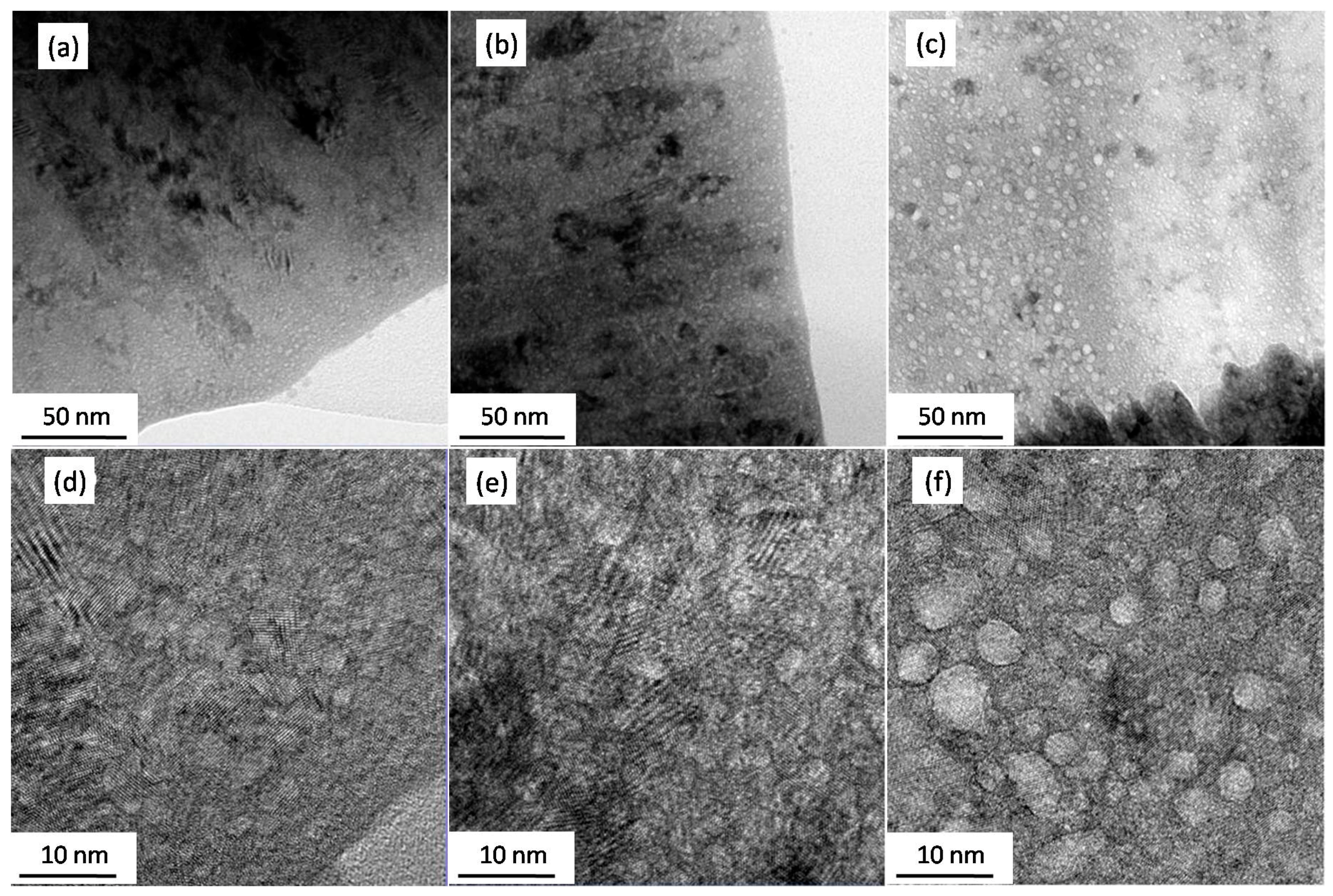
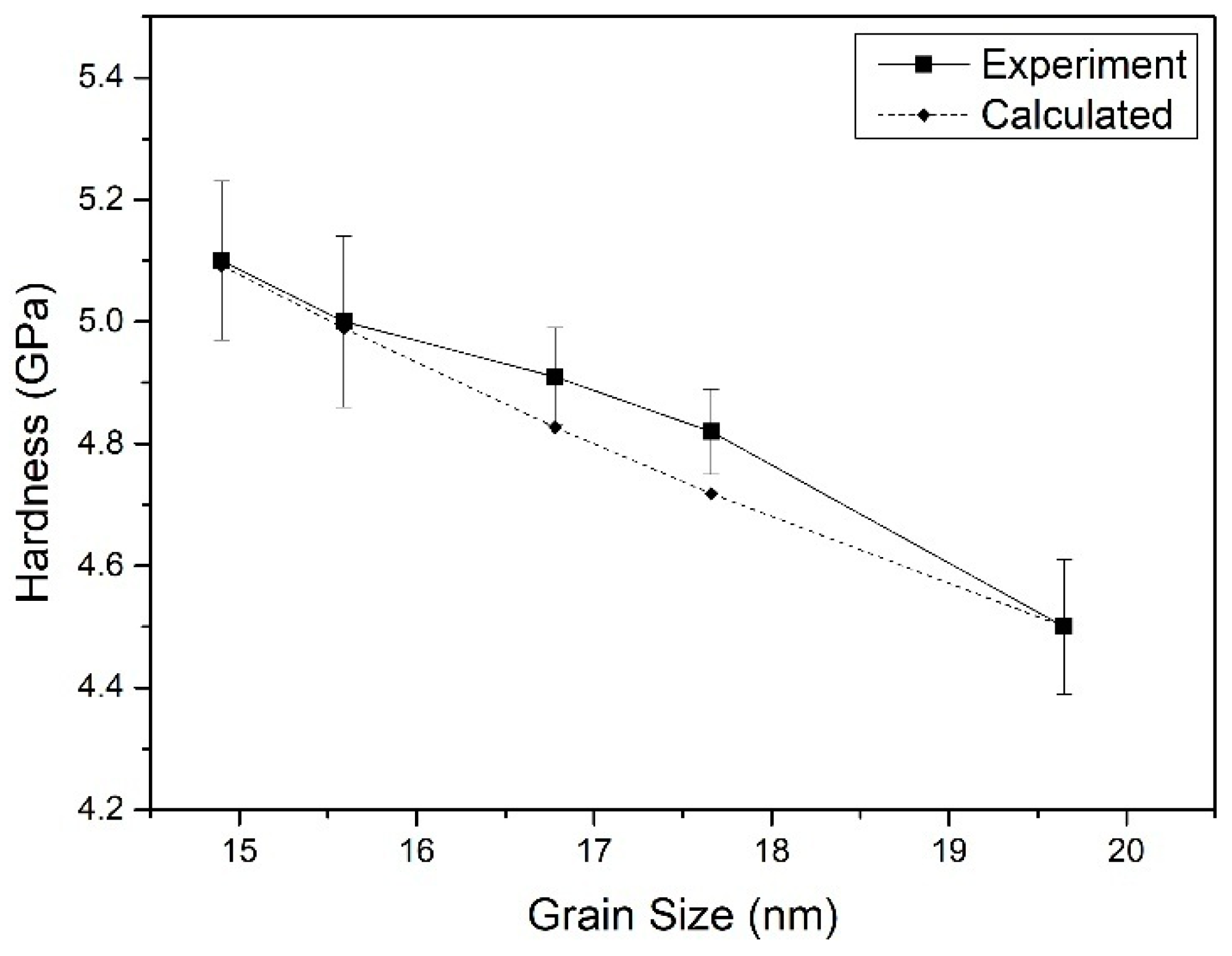
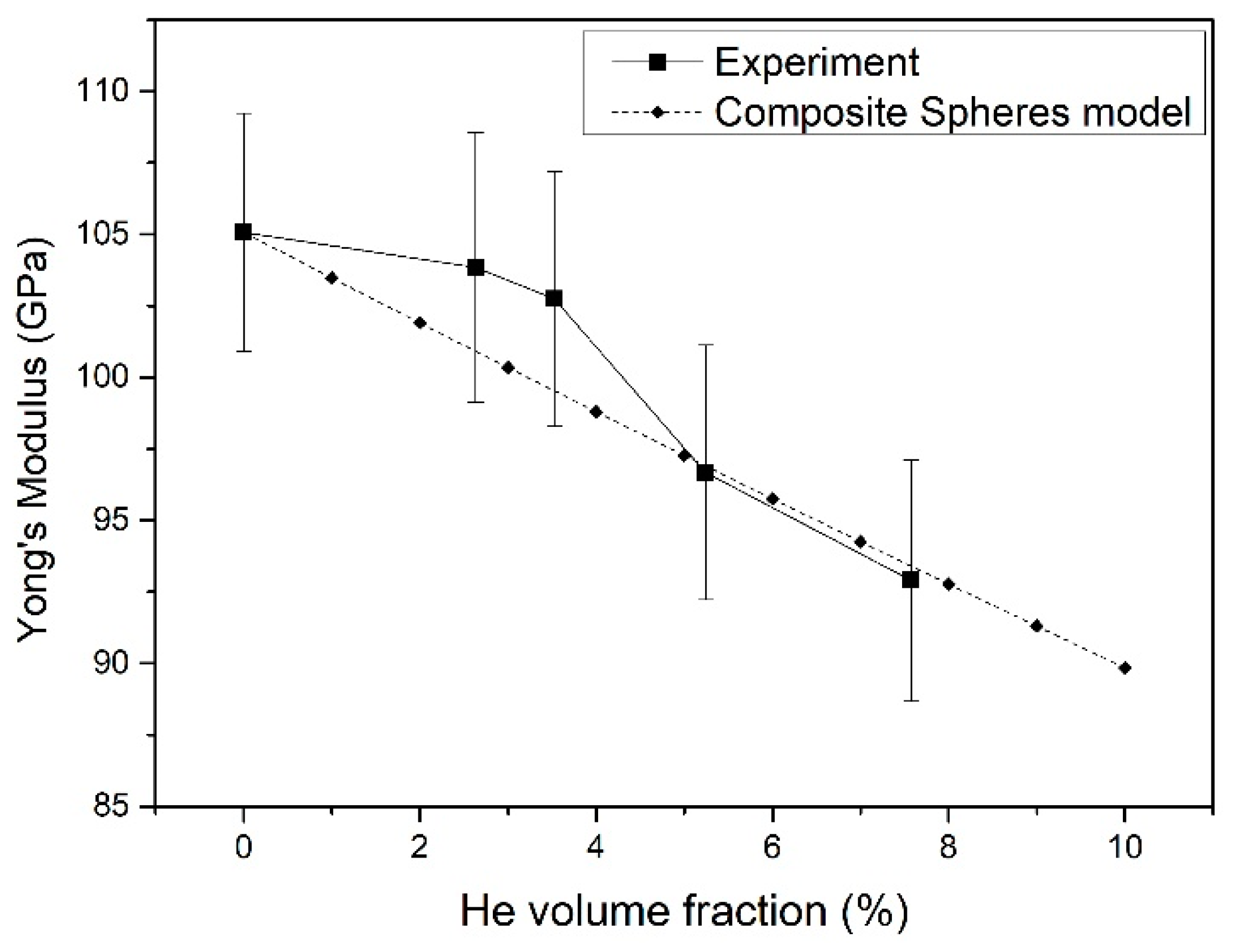
| Flow Ratio of He:Ar | Deposited Rate /(nm/min) | Film Thickness /(µm) | He Concentration /(%) |
|---|---|---|---|
| 0:1 | 60.0 | 1.80 | 0 |
| 6:1 | 48.0 | 1.44 | 3.04 |
| 9:1 | 42.7 | 1.28 | 25.18 |
| 13:1 | 42.3 | 1.27 | 29.80 |
| 18:1 | 31.7 | 0.95 | 49.60 |
| He:Ar | He Concentration /(%) | 2θ of (100) Peak /(°) | Normalized Peak Height/(%) | FWHM /(°) | Grain Size/(nm) |
|---|---|---|---|---|---|
| 0:0 | 0 | 28.77 | 31.37 | 0.445 | 19.7 |
| 6:1 | 3.04 | 28.80 | 23.29 | 0.459 | 17.7 |
| 9:1 | 25.18 | 28.76 | 63.71 | 0.483 | 16.8 |
| 13:1 | 29.81 | 28.68 | 49.07 | 0.520 | 15.6 |
| 18:1 | 49.60 | 28.64 | 171.41 | 0.544 | 14.9 |
© 2019 by the authors. Licensee MDPI, Basel, Switzerland. This article is an open access article distributed under the terms and conditions of the Creative Commons Attribution (CC BY) license (http://creativecommons.org/licenses/by/4.0/).
Share and Cite
Fu, W.; Shen, H.; Shi, L.; Zhou, X.; Long, X. Effects of Embedded Helium on the Microstructure and Mechanical Properties of Erbium Films. Nanomaterials 2019, 9, 1564. https://doi.org/10.3390/nano9111564
Fu W, Shen H, Shi L, Zhou X, Long X. Effects of Embedded Helium on the Microstructure and Mechanical Properties of Erbium Films. Nanomaterials. 2019; 9(11):1564. https://doi.org/10.3390/nano9111564
Chicago/Turabian StyleFu, Wenbo, Huahai Shen, Liqun Shi, Xiaosong Zhou, and Xinggui Long. 2019. "Effects of Embedded Helium on the Microstructure and Mechanical Properties of Erbium Films" Nanomaterials 9, no. 11: 1564. https://doi.org/10.3390/nano9111564
APA StyleFu, W., Shen, H., Shi, L., Zhou, X., & Long, X. (2019). Effects of Embedded Helium on the Microstructure and Mechanical Properties of Erbium Films. Nanomaterials, 9(11), 1564. https://doi.org/10.3390/nano9111564





